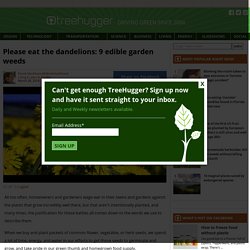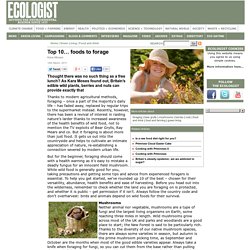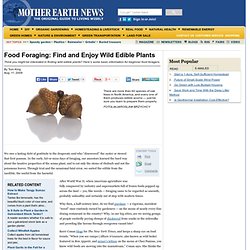

Food Foraging: Wild Edible Plants & Mushrooms. Wild Food Foraging. Wild Edible & Medicinal Plants - Tribe.net. 9 Common Edible Garden Weeds. All too often, homeowners and gardeners wage war in their lawns and gardens against the plants that grow incredibly well there, but that aren't intentionally planted, and many times, the justification for these battles all comes down to the words we use to describe them.

When we buy and plant packets of common flower, vegetable, or herb seeds, we spend a lot of time, energy, and water in our efforts to get those seeds to germinate and grow, and take pride in our green thumb and homegrown food supply. But when a plant that we identify as being a weed is found growing in our lawn or garden, out comes the trowel and hoe (or for the ruthless and impatient gardeners, weedkillers such as RoundUp), and we may spend the entire growing season keeping these opportunistic and resilient plants at bay, in order to have neat and tidy garden beds and uniform lawns. 1.
Dandelion 2. ZooFari/CC BY 3.0 3. Cliff/CC BY 3.0 4. Wendell Smith/CC BY 3.0 5. Calin Darabus/CC BY 3.0 6. Leslie Seaton/CC BY 3.0. Top 10 Invasive Species You Can Eat. 5 Invasive Plants You Can Eat. The logic of eating wild plants is obvious; the logic of eating invasive wild plants is even more so.

Culling aggressive species that have a negative impact on native plants, while avoiding the environmental pitfalls of agriculture? And free, local and abundant? Yes, please. Invasive plants are non-native species that can thrive in areas beyond their natural range of dispersal. These plants are characteristically adaptable, aggressive, and have a high reproductive capacity. According to the Land Management Bureau, millions of acres of once-healthy, productive rangelands, forestlands and riparian areas have been overrun by noxious or invasive plants. So what can we do? 1. Native range: Old World, probably Southeast Asian in origin Invasive range: Throughout North America Habitat: Rocky bluffs, barnyards, gardens, sidewalk cracks, disturbed areas; widely found in city lots. 2. The pretty leaves are alternate, egg shaped; stems are hollow. Top 10… Foods To Forage - Green Living.
Thanks to modern agricultural methods, foraging – once a part of the majority’s daily life – has faded away, replaced by regular trips to the supermarket instead.

Recently, however, there has been a revival of interest in raiding nature’s larder thanks to increased awareness of the health benefits of wild food, not to mention the TV exploits of Bear Grylls, Ray Mears and co. But it foraging is about more than just food. It gets us out into the countryside and helps to cultivate an intimate appreciation of nature, re-establishing a connection severed by modern urban life. But for the beginner, foraging should come with a health warning as it’s easy to mistake a deadly fungus for an innocent field mushroom. While wild food is generally good for you, taking precautions and getting some tips and advice from experienced foragers is essential. Mushrooms Neither animal nor vegetable, mushrooms are a type of fungi and the largest living organisms on Earth, some reaching three miles in length. Foraging Articles. Food Foraging: Find Wild Edible Plants - Mother Earth News.
We owe a lasting debt of gratitude to the desperate soul who “discovered” the oyster or stewed that first possum.

In the early, hit-or-miss days of foraging, our ancestors learned the hard way about the laxative properties of the senna plant, and to eat only the stems of rhubarb and not the poisonous leaves. Through trial and the occasional fatal error, we sorted the edible from the inedible, the useful from the harmful. After World War II, when American agriculture was fully conquered by industry and supermarkets full of frozen foods popped up across the land — yes, like weeds — foraging came to be regarded as uncouth, probably unhealthy and certainly out of step with modern times. Why then, a half-century later, do we find purslane — a vigorous, succulent “weed” once routinely cursed by gardeners — on the menu of nearly every fine dining restaurant in the country? Kerri Conan blogs for The New York Times, and keeps a sharp eye on food trends. Learning the Art of Food Foraging.